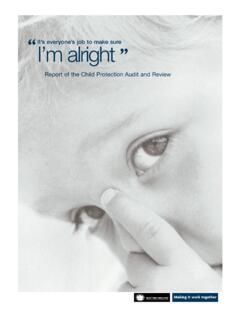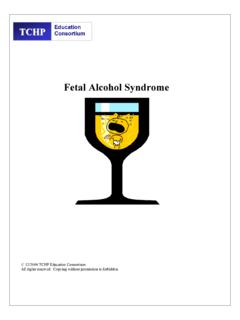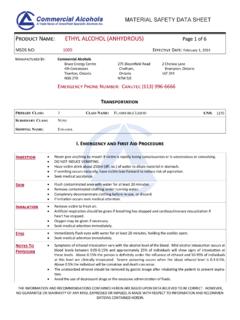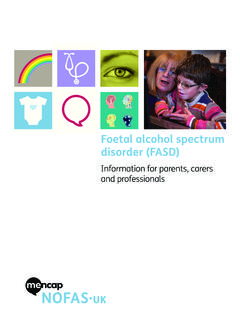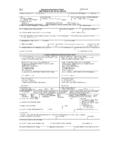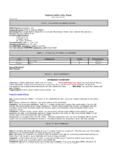Transcription of Alcohol Units - lx.iriss.org.uk
1 1 Alcohol Units A brief guide23As typical glass sizes have grown and popular drinks have increased in strength over the years, the old rule of thumb that a glass of wine was about 1 unit has become out of date. Nowadays, a large glass of wine might well contain 3 Units or more about the same amount as a treble how do you know how much is in your drink?A UK unit is 10 millilitres (8 grams) of pure Alcohol . It s actually the amount of Alcohol that an average healthy adult body can break down in about an hour. So, if you drink 10ml of pure Alcohol , 60 minutes later there should be virtually none left in your bloodstream. You could still be suffering some of the effects the Alcohol has had on your body though, such as feeling thirsty if you hadn t drunk any , bottles and cans show the number of Units they contain.
2 Tables like the one at the back of this leaflet and online calculators ( ) also provide unit information for a range of common drinks. Good labelling should mean you won t normally need to work it out, but the exact number of Units in any alcoholic drink can always be found by calculating the amount of pure Alcohol in it. You just need to know the volume and how strong the drink is given by the percentage of Alcohol by volume (ABV). The ABV is widely available and shown on beer pumps, bottles, cans and so example, most whisky has an ABV of 40%. A 1 litre (1,000ml) bottle of this whisky therefore contains 400ml of pure Alcohol . This is 40 Units (as 10ml of pure Alcohol = one unit). So, in 100ml of the whisky, there would be 4 Units .
3 And hence, a 25ml single measure of whisky would contain 1 maths is straightforward. To calculate Units , take the quantity in millilitres, multiply it by the ABV (expressed as a percentage) and divide by 1,000. In the example of a glass of whisky (above) the calculation would be: 25ml x 40% = 1 unit. 1,000Or, for a 250ml glass of wine with ABV 12%, the number of Units is: 250ml x 12% = 3 Units . 1,000A 330ml bottle of lager (ABV 5%) contains: 330ml x 5% = Units . 1,000To work out Units when volume is expressed in pints, you need to convert to millilitres. 1 pint is 568ml, so as an approximation, 1 pint can be considered as 500ml. So, for 1 pint of beer (ABV 4%), the calculation would be roughly: 500ml (1 pint) x 4% = 2 Units *.
4 1,000 Units of Alcohol explained Alcohol Units A brief guide*Because in this case the volume of a pint in mls was rounded down, the actual number of Units is a little more than this heavily in one session, including drinking to get drunk, can create risks of injury and accident, and can make you and others vulnerable in particular situations. While drinking a lot of Alcohol in one go may not affect your long-term health, it can certainly affect you in the short term and is responsible for a significant number of Alcohol -related effects of Alcohol on long-term health depend on the amount drunk and the frequency of NHS recommends that men should not regularly drink more than 3-4 Units of Alcohol daily and women should not regularly drink more than 2-3 Units daily.
5 Why?The advice is based on scientific evidence from studies in the population as a whole in this country and others about long-term health harms for broadly average, healthy adults. Up to these levels, an individual s risk of contracting Alcohol -related illness is considered to be statistically low. Above these limits, the risk of long-term health harms starts to become significant and increases progressively the more you exceed these guidelines see below. Why is there no exact limit?The limit is set as a range (2-3 and 3-4 Units ) because the science shows that there is no single exact cut-off that applies to every person every day. Rather it gives a good indication of the limit that should not be exceeded on a regular basis.
6 The limits are lower for women because their bodies are less effective than men s at breaking down Alcohol , putting them at higher risk of does regularly mean? Regularly refers to drinking every day or most days of the week and does not refer to regular consumption just once a 1995, the government advice on sensible drinking was based on weekly, rather than daily, limits. The advice was changed in 1995 to daily limits (for regular consumption). This was mainly because some people had misinterpreted the weekly amounts, believing it was safe to store up their weekly allowance until the weekend, when they would drink heavily. In fact, short-term episodes of heavy drinking or binge drinking are often associated with injuries, accidents and social advice on Alcohol consumptionAlcohol Units A brief guideIncreased riskHigh risk* Regularly here means every day or most days of the week (not just drinking at these levels once a week) Alcohol health risks how much is too much?
7 Men who re gularly* drink:Women who regularly* drink:HIGHER RISK over8 Units per day (over 50 unitsper week)over6 Units per day (over 35 unitsper week)over3-4 Units per day over2-3 Units per day INCREASING RISKLOWER RISKno more than 3-4 Units per dayno more than 2-3 Units per day5 Individual circumstancesThe NHS advises that it is important for people to think carefully about how much to drink on certain occasions, for example when responsible for the care of children or when driving, swimming, operating machinery, etc. It may be appropriate not to drink at all in these can be advisable for some individuals to drink much less than the regular drinking limits, because of their own identified personal risks.
8 For example, for some people mental health problems may be aggravated by Alcohol , so they may choose to avoid drinking completely at certain times. For some illnesses, increased risks occur as soon as any Alcohol is consumed. For example, regular drinking of Alcohol slightly increases the risk of future breast cancer although the additional risk is small for most women. The NHS describes its recommended drinking limits as lower-risk rather than completely safe because of such and conceptionSpecific advice has been developed for pregnant women and those trying to conceive based on analysis of the evidence of the potential for harm to a developing advice is that: Pregnant women or women trying to conceive should avoid drinking Alcohol .
9 If they do choose to drink, to protect the baby they should not drink more than 1-2 Units of Alcohol once or twice a week and should not get National Institute for Health and Clinical Excellence (NICE) advises women to avoid Alcohol in the first three months of pregnancy in particular, because of the increased risk of there is believed to be little risk associated with consuming below 1 or 2 Units once or twice a week, the evidence base for limited risk comes from a small number of studies. Ignorance of Units themselves also means that some women might unknowingly put their unborn child at risk by consuming more Units than they realise. The NHS has taken the view that precautionary advice is right for an area where the health harm can be severe and who drink heavily during pregnancy put their babies at particular risk of development of fetal Alcohol syndrome or fetal Alcohol spectrum disorder.
10 These disorders lead to lifelong intellectual and behavioural problems for the child and may shorten benefitsThere is evidence that regularly drinking low levels of Alcohol (around 1 unit a day) can confer a health benefit (mainly a cardiovascular benefit1) for middle-aged and older people. The NHS does not explicitly advise that everyone who might benefit should drink in this way, as the same or greater benefits might occur with just exercise and a good diet, but it may be valuable for some on long-term healthDrinking regularly over the recommended limits increases health risks over the long term. Even consumption slightly above guideline levels for lower-risk drinking contributes to significant numbers of and women who drink over double the recommended limits increase their chances of contracting the illnesses in the table2 below by the multiples shown compared with people who drink below the limits.


